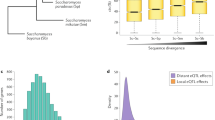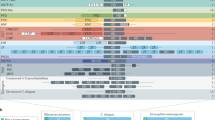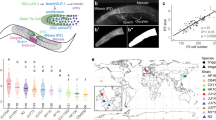Abstract
The phenotypic differences between individual organisms can often be ascribed to underlying genetic and environmental variation. However, even genetically identical organisms in homogeneous environments vary, indicating that randomness in developmental processes such as gene expression may also generate diversity. To examine the consequences of gene expression variability in multicellular organisms, we studied intestinal specification in the nematode Caenorhabditis elegans in which wild-type cell fate is invariant and controlled by a small transcriptional network. Mutations in elements of this network can have indeterminate effects: some mutant embryos fail to develop intestinal cells, whereas others produce intestinal precursors. By counting transcripts of the genes in this network in individual embryos, we show that the expression of an otherwise redundant gene becomes highly variable in the mutants and that this variation is subjected to a threshold, producing an ON/OFF expression pattern of the master regulatory gene of intestinal differentiation. Our results demonstrate that mutations in developmental networks can expose otherwise buffered stochastic variability in gene expression, leading to pronounced phenotypic variation.
This is a preview of subscription content, access via your institution
Access options
Subscribe to this journal
Receive 51 print issues and online access
$199.00 per year
only $3.90 per issue
Buy this article
- Purchase on Springer Link
- Instant access to full article PDF
Prices may be subject to local taxes which are calculated during checkout




Similar content being viewed by others
References
Horvitz, H. R. & Sulston, J. E. Isolation and genetic characterization of cell-lineage mutants of the nematode Caenorhabditis elegans . Genetics 96, 435–454 (1980)
Laubichler, M. & Sarkur, S. in Mutating Concepts, Evolving Disciplines: Genetics, Medicine and Society (eds Parker, L. S. & Ankeny, R. A.) 63–85 (Kluwer, 2002)
Romaschoff, D. D. Über die Variabilität in der Manifestierung eines erblichen Merkmales (Abdomen abnormalis) bei Drosophila funebris F. J. Psychol. Neurol. 31, 323–325 (1925)
Timoféeff-Ressovsky, N. W. Über den Einfluss des Genotypus auf das phänotypen Auftreten eines einzelnes Gens. J. Psychol. Neurol. 31, 305–310 (1925)
Vogt, O. Psychiatrisch wichtige Tatsachen der zoologisch-botanischen Systematik. Zeitschrift für die gesamte . Neurol. Psychiatr. (Bucur.) 101, 805–832 (1926)
Raj, A. & Van Oudenaarden, A. Nature, nurture, or chance: stochastic gene expression and its consequences. Cell 135, 216–226 (2008)
Elowitz, M. B., Levine, A. J., Siggia, E. D. & Swain, P. S. Stochastic gene expression in a single cell. Science 297, 1183–1186 (2002)
Maamar, H., Raj, A. & Dubnau, D. Noise in gene expression determines cell fate in Bacillus subtilis . Science 317, 526–529 (2007)
Ozbudak, E. M., Thattai, M., Kurtser, I., Grossman, A. D. & van Oudenaarden, A. Regulation of noise in the expression of a single gene. Nature Genet. 31, 69–73 (2002)
Süel, G. M., Kulkarni, R. P., Dworkin, J., Garcia-Ojalvo, J. & Elowitz, M. B. Tunability and noise dependence in differentiation dynamics. Science 315, 1716–1719 (2007)
Chang, H. H., Hemberg, M., Barahona, M., Ingber, D. E. & Huang, S. Transcriptome-wide noise controls lineage choice in mammalian progenitor cells. Nature 453, 544–547 (2008)
Hume, D. A. Probability in transcriptional regulation and its implications for leukocyte differentiation and inducible gene expression. Blood 96, 2323–2328 (2000)
Wernet, M. F. et al. Stochastic spineless expression creates the retinal mosaic for colour vision. Nature 440, 174–180 (2006)
Raj, A., van den Bogaard, P., Rifkin, S. A., Van Oudenaarden, A. & Tyagi, S. Imaging individual mRNA molecules using multiple singly labeled probes. Nature Methods 5, 877–879 (2008)
Fukushige, T., Hawkins, M. G. & McGhee, J. D. The GATA-factor elt-2 is essential for formation of the Caenorhabditis elegans intestine. Dev. Biol. 198, 286–302 (1998)
McGhee, J. et al. ELT-2 is the predominant transcription factor controlling differentiation and function of the C. elegans intestine, from embryo to adult. Dev. Biol. 327, 551–565 (2009)
McGhee, J. D. et al. The ELT-2 GATA-factor and the global regulation of transcription in the C. elegans intestine. Dev. Biol. 302, 627–645 (2007)
Maduro, M. F., Meneghini, M. D., Bowerman, B., Broitman-Maduro, G. & Rothman, J. H. Restriction of mesendoderm to a single blastomere by the combined action of SKN-1 and a GSK-3β homolog is mediated by MED-1 and -2 in C. elegans . Mol. Cell 7, 475–485 (2001)
Maduro, M. F., Broitman-Maduro, G., Mengarelli, I. & Rothman, J. H. Maternal deployment of the embryonic SKN-1→MED-1,2 cell specification pathway in C. elegans . Dev. Biol. 301, 590–601 (2007)
Zhu, J. et al. end-1 encodes an apparent GATA factor that specifies the endoderm precursor in Caenorhabditis elegans embryos. Genes Dev. 11, 2883–2896 (1997)
Zhu, J., Fukushige, T., McGhee, J. D. & Rothman, J. H. Reprogramming of early embryonic blastomeres into endodermal progenitors by a Caenorhabditis elegans GATA factor. Genes Dev. 12, 3809–3814 (1998)
Maduro, M. F. et al. Genetic redundancy in endoderm specification within the genus Caenorhabditis . Dev. Biol. 284, 509–522 (2005)
Fukushige, T., Hendzel, M. J., Bazett-Jones, D. P. & McGhee, J. D. Direct visualization of the elt-2 gut-specific GATA factor binding to a target promoter inside the living Caenorhabditis elegans embryo. Proc. Natl Acad. Sci. USA 96, 11883–11888 (1999)
Bowerman, B., Eaton, B. A. & Priess, J. R. skn-1, a maternally expressed gene required to specify the fate of ventral blastomeres in the early C. elegans embryo. Cell 68, 1061–1075 (1992)
Maduro, M. Structure and evolution of the C. elegans embryonic endomesoderm network. Biochim. Biophys. Acta 1789, 250–260 (2009)
McGhee, J. D. The C. elegans intestine. WormBook 1–36 〈http://www.wormbook.org/chapters/www_intestine/intestine.html〉 (2007)
Goszczynski, B. & McGhee, J. D. Reevaluation of the role of the med-1 and med-2 genes in specifying the Caenorhabditis elegans endoderm. Genetics 171, 545–555 (2005)
Seydoux, G. & Fire, A. Soma-germline asymmetry in the distributions of embryonic RNAs in Caenorhabditis elegans . Development 120, 2823–2834 (1994)
Lin, R., Thompson, S. & Priess, J. R. pop-1 encodes an HMG box protein required for the specification of a mesoderm precursor in early C. elegans embryos. Cell 83, 599–609 (1995)
Calvo, D. et al. A POP-1 repressor complex restricts inappropriate cell type-specific gene transcription during Caenorhabditis elegans embryogenesis. EMBO J. 20, 7197–7208 (2001)
Maduro, M. F., Kasmir, J. J., Zhu, J. & Rothman, J. H. The Wnt effector POP-1 and the PAL-1/Caudal homeoprotein collaborate with SKN-1 to activate C. elegans endoderm development. Dev. Biol. 285, 510–523 (2005)
Raj, A., Peskin, C. S., Tranchina, D., Vargas, D. Y. & Tyagi, S. Stochastic mRNA synthesis in mammalian cells. PLoS Biol. 4, e309 (2006)
Raser, J. M. & O’Shea, E. K. Control of stochasticity in eukaryotic gene expression. Science 304, 1811–1814 (2004)
Voss, T. C., John, S. & Hager, G. L. Single-cell analysis of glucocorticoid receptor action reveals that stochastic post-chromatin association mechanisms regulate ligand-specific transcription. Mol. Endocrinol. 20, 2641–2655 (2006)
Shi, Y. & Mello, C. A. CBP/p300 homolog specifies multiple differentiation pathways in Caenorhabditis elegans . Genes Dev. 12, 943–955 (1998)
Walker, A. K. et al. A conserved transcription motif suggesting functional parallels between Caenorhabditis elegans SKN-1 and Cap’n’Collar-related basic leucine zipper proteins. J. Biol. Chem. 275, 22166–22171 (2000)
Chubb, J., Trcek, T., Shenoy, S. M. & Singer, R. H. Transcriptional pulsing of a developmental gene. Curr. Biol. 16, 1018–1025 (2006)
Golding, I., Paulsson, J., Zawilski, S. M. & Cox, E. C. Real-time kinetics of gene activity in individual bacteria. Cell 123, 1025–1036 (2005)
Peccoud, J. & Ycart, B. Markovian modelling of gene product synthesis. Theor. Popul. Biol. 48, 222–234 (1995)
Nowak, M. A., Boerlijst, M. C., Cooke, J. & Smith, J. M. Evolution of genetic redundancy. Nature 388, 167–171 (1997)
Maduro, M. F., Lin, R. & Rothman, J. H. Dynamics of a developmental switch: recursive intracellular and intranuclear redistribution of Caenorhabditis elegans POP-1 parallels Wnt-inhibited transcriptional repression. Dev. Biol. 248, 128–142 (2002)
Broitman-Maduro, G., Maduro, M. F. & Rothman, J. H. The noncanonical binding site of the MED-1 GATA factor defines differentially regulated target genes in the C. elegans mesendoderm. Dev. Cell 8, 427–433 (2005)
Bergman, A. & Siegal, M. L. Evolutionary capacitance as a general feature of complex gene networks. Nature 424, 549–552 (2003)
Wagner, G. P., Booth, G. & Bagheri-Chaichian, H. A population genetic theory of canalization. Evolution 51, 329–347 (1997)
Jeong, H., Mason, S. P., Barabási, A. L. & Oltvai, Z. N. Lethality and centrality in protein networks. Nature 411, 41–42 (2001)
Levy, S. F. & Siegal, M. L. Network hubs buffer environmental variation in Saccharomyces cerevisiae . PLoS Biol. 6, e264 (2008)
Waddington, C. H. Organisers and Genes (Cambridge Univ. Press, 1940)
Queitsch, C., Sangster, T. A. & Lindquist, S. Hsp90 as a capacitor of phenotypic variation. Nature 417, 618–624 (2002)
Rutherford, S. L. & Lindquist, S. Hsp90 as a capacitor for morphological evolution. Nature 396, 336–342 (1998)
Eldar, A. et al. Partial penetrance facilitates developmental evolution in bacteria. Nature 460, 510–514 (2009)
Acknowledgements
We thank H. R. Horvitz for early discussions and technical assistance. We also thank H. R. Horvitz and J. Gore for a critical reading of the manuscript. This work was funded by a National Institutes of Health (NIH) Director’s Pioneer Award to A.v.O. A.R. was supported by a National Science Foundation MSPRF fellowship DMS-0603392 and a Burroughs-Wellcome Fund Career Award at the Scientific Interface. S.A.R. was supported by an NIH NRSA postdoctoral fellowship 5F32GM080966.
Author Contributions A.R. and S.A.R. performed the experiments. A.R., S.A.R. and E.A. constructed the GFP-labelled skn-1 strains. A.R., S.A.R. and A.v.O. designed the experiments, analysed the data and wrote the manuscript.
Author information
Authors and Affiliations
Corresponding author
Ethics declarations
Competing interests
The authors declare no competing financial interests.
Supplementary information
Supplementary Figures
This file contains Supplementary Figures 1-19 with Legends. (PDF 1617 kb)
Rights and permissions
About this article
Cite this article
Raj, A., Rifkin, S., Andersen, E. et al. Variability in gene expression underlies incomplete penetrance. Nature 463, 913–918 (2010). https://doi.org/10.1038/nature08781
Received:
Accepted:
Issue Date:
DOI: https://doi.org/10.1038/nature08781
This article is cited by
-
Stochastic gene expression and environmental stressors trigger variable somite segmentation phenotypes
Nature Communications (2023)
-
Nucleocytoplasmic transport of active HER2 causes fractional escape from the DCIS-like state
Nature Communications (2023)
-
Higher-order epistasis shapes natural variation in germ stem cell niche activity
Nature Communications (2023)
-
Tooth ultrastructure changes induced by a nonsense mutation in the FAM83H gene: insights into the diversity of amelogenesis imperfecta
Clinical Oral Investigations (2023)
-
Microtubules as a potential platform for energy transfer in biological systems: a target for implementing individualized, dynamic variability patterns to improve organ function
Molecular and Cellular Biochemistry (2023)
Comments
By submitting a comment you agree to abide by our Terms and Community Guidelines. If you find something abusive or that does not comply with our terms or guidelines please flag it as inappropriate.



